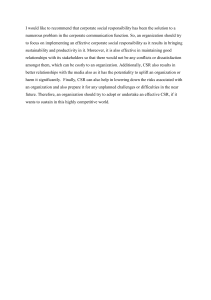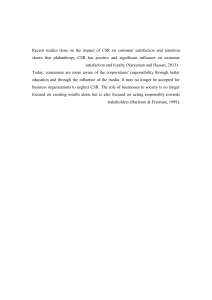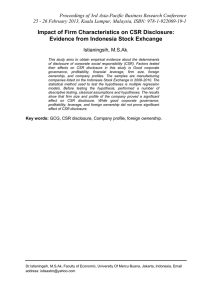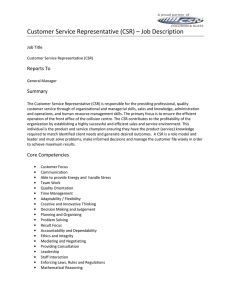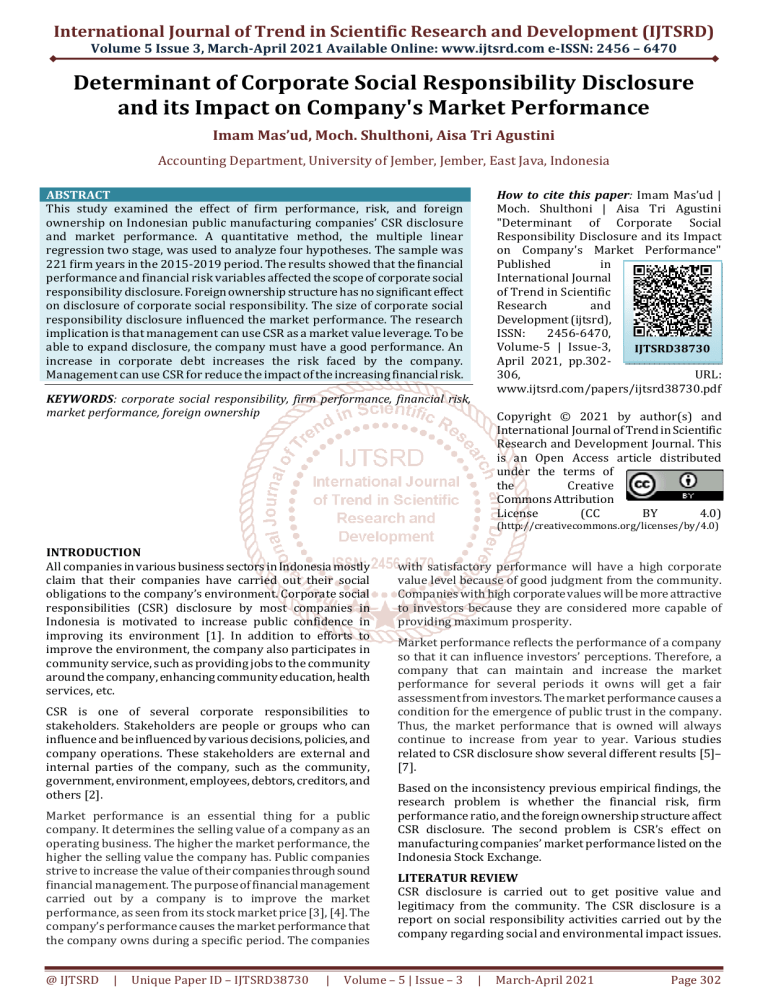
International Journal of Trend in Scientific Research and Development (IJTSRD)
Volume 5 Issue 3, March-April 2021 Available Online: www.ijtsrd.com e-ISSN: 2456 – 6470
Determinant of Corporate Social Responsibility Disclosure
and its Impact on Company's Market Performance
Imam Mas’ud, Moch. Shulthoni, Aisa Tri Agustini
Accounting Department, University of Jember, Jember, East Java, Indonesia
How to cite this paper: Imam Mas’ud |
Moch. Shulthoni | Aisa Tri Agustini
"Determinant of Corporate Social
Responsibility Disclosure and its Impact
on Company's Market Performance"
Published
in
International Journal
of Trend in Scientific
Research
and
Development (ijtsrd),
ISSN:
2456-6470,
Volume-5 | Issue-3,
IJTSRD38730
April 2021, pp.302306,
URL:
www.ijtsrd.com/papers/ijtsrd38730.pdf
ABSTRACT
This study examined the effect of firm performance, risk, and foreign
ownership on Indonesian public manufacturing companies’ CSR disclosure
and market performance. A quantitative method, the multiple linear
regression two stage, was used to analyze four hypotheses. The sample was
221 firm years in the 2015-2019 period. The results showed that the financial
performance and financial risk variables affected the scope of corporate social
responsibility disclosure. Foreign ownership structure has no significant effect
on disclosure of corporate social responsibility. The size of corporate social
responsibility disclosure influenced the market performance. The research
implication is that management can use CSR as a market value leverage. To be
able to expand disclosure, the company must have a good performance. An
increase in corporate debt increases the risk faced by the company.
Management can use CSR for reduce the impact of the increasing financial risk.
KEYWORDS: corporate social responsibility, firm performance, financial risk,
market performance, foreign ownership
Copyright © 2021 by author(s) and
International Journal of Trend in Scientific
Research and Development Journal. This
is an Open Access article distributed
under the terms of
the
Creative
Commons Attribution
License
(CC
BY
4.0)
(http://creativecommons.org/licenses/by/4.0)
INTRODUCTION
All companies in various business sectors in Indonesia mostly
claim that their companies have carried out their social
obligations to the company’s environment. Corporate social
responsibilities (CSR) disclosure by most companies in
Indonesia is motivated to increase public confidence in
improving its environment [1]. In addition to efforts to
improve the environment, the company also participates in
community service, such as providing jobs to the community
around the company, enhancing community education, health
services, etc.
CSR is one of several corporate responsibilities to
stakeholders. Stakeholders are people or groups who can
influence and be influenced by various decisions, policies, and
company operations. These stakeholders are external and
internal parties of the company, such as the community,
government, environment, employees, debtors, creditors, and
others [2].
Market performance is an essential thing for a public
company. It determines the selling value of a company as an
operating business. The higher the market performance, the
higher the selling value the company has. Public companies
strive to increase the value of their companies through sound
financial management. The purpose of financial management
carried out by a company is to improve the market
performance, as seen from its stock market price [3], [4]. The
company’s performance causes the market performance that
the company owns during a specific period. The companies
@ IJTSRD
|
Unique Paper ID – IJTSRD38730
|
with satisfactory performance will have a high corporate
value level because of good judgment from the community.
Companies with high corporate values will be more attractive
to investors because they are considered more capable of
providing maximum prosperity.
Market performance reflects the performance of a company
so that it can influence investors’ perceptions. Therefore, a
company that can maintain and increase the market
performance for several periods it owns will get a fair
assessment from investors. The market performance causes a
condition for the emergence of public trust in the company.
Thus, the market performance that is owned will always
continue to increase from year to year. Various studies
related to CSR disclosure show several different results [5]–
[7].
Based on the inconsistency previous empirical findings, the
research problem is whether the financial risk, firm
performance ratio, and the foreign ownership structure affect
CSR disclosure. The second problem is CSR’s effect on
manufacturing companies’ market performance listed on the
Indonesia Stock Exchange.
LITERATUR REVIEW
CSR disclosure is carried out to get positive value and
legitimacy from the community. The CSR disclosure is a
report on social responsibility activities carried out by the
company regarding social and environmental impact issues.
Volume – 5 | Issue – 3
|
March-April 2021
Page 302
International Journal of Trend in Scientific Research and Development (IJTSRD) @ www.ijtsrd.com eISSN: 2456-6470
The information is an integral part of the annual report
accountable to the directors’ board before the shareholders’
general meeting.
CSR disclosures are generally voluntary, unaudited, and
unregulated [8], [9]. Therefore, business entities have the
freedom to disclose information that is not required by the
capital market administering bodies. Diversity in disclosure is
caused by business entities managed by managers who have
different managerial philosophical views and the breadth
concerning disclosing information to the public. The company
has now begun to realize that its survival depends on its
relationship with its community and environment. The
company’s activities must reflect or be following the values
contained in society.
Research Hypothesis
Stakeholder theory states that companies need to provide
information about their stakeholders’ firm performance to
know its activities. The higher the level of firm performance,
the greater the CSR level to describe its performance so that
the community can accept the company [10], [11].
Companies that generate profits have an incentive to
differentiate themselves from other companies that are less
profitable. One way to differentiate yourself is by providing
CSR information. Companies that have bad news tend not to
disclose information related to bad news to the market,
aiming that its value does not decrease. Companies with good
news will convey information to the market, where one way
is in the form of a complete CSR disclosure in the annual
report [12], [13]. Full information on annual reports is
expected to have a positive impact on the company. If the
disclosure of good news is not carried out, the market will
interpret it as bad news to impact its low valuation.
Companies with high firm performance will tend to provide
more detailed information because they want to convince
investors of their firm performance. Also, companies that
have high firm performance have more opportunities to carry
out CSR activities. Companies will provide more detailed
disclosures regarding their social responsibility so that the
public, investors, creditors, and other interested parties know
with certainty the company’s social responsibility [14], [15].
The low firm performance encourages managers to disclose
company information more broadly to convince all existing
stakeholders. The first hypothesis proposed is:
H1: The firm performance affects the disclosure of CSR public
manufacturing companies.
Financial risk is a tool to measure how much a company
depends on creditors in financing its assets. The high level of
loans encourages creditors to take an active role in
overseeing the company. Debt provides a signal about the
company’s financial condition to find out its obligations.
Therefore, companies need to provide other information to
divert their supervision, such as disclosing social
responsibility activities [16].
Companies with a high financial risk ratio will disclose more
increased social disclosures because the financial risk ratio is
used to view the risk of debt uncollectibility [17]. Additional
information is needed to remove doubts from bondholders
regarding the fulfillment of their rights as creditors. Larger
financial risks companies are due to higher debt. It can lead to
a decrease in other parties’ confidence in the company’s
ability to return its funds.
@ IJTSRD
|
Unique Paper ID – IJTSRD38730
|
Companies with high financial risk need to provide more
disclosure because they have to explain to investors,
creditors, or other interested parties about their ability to pay
debts and the impact of these loans on CSR, employees, and
the company’s community and environment [18]. Companies
with high financial risk ratios try to convey more information
as an instrument to reduce monitoring costs for investors so
that companies with high financial risk will disclose more
social responsibility information than companies with lower
financial risk [19], [20]. The second hypothesis proposed is:
H2: The firm financial risk affects the disclosure of CSR public
manufacturing companies.
Foreign ownership is the proportion of ownership by foreign
individuals and institutions. Many studies use foreign
ownership as an independent variable that affects CSR
disclosure in company annual reports. The more significant
the proportion of company share ownership owned by the
public, the more parties will need information about the
company to disclose more items in the annual report. In this
case, the definition of a public is outside management and
does not have a special relationship with the company [21].
The difference in the proportion of shares owned by
outsiders will increasingly affect its completeness of
disclosure. Lower concentration of ownership results in a
conflict of interest between the principal and the agent [22].
Management should disclose more voluntary information to
meet the demands of shareholders spread to the public to
reduce the potential for higher agency costs and prevent
information asymmetry between the principal and the agent
[1], [21]. The third hypothesis proposed is:
H3: The structure of the company’s foreign ownership affects
the extent of the disclosure of CSR manufacturing companies
CSR is a business way of aligning market performances and
their society and external stakeholders. The CSR program can
contribute to the development of the social environment in
which the company operates. CSR can contribute to
sustainable economic growth, thereby improving the quality
of life. CSR activities can also help companies gain legitimacy
for their business operation activities.
CSR disclosure will be submitted to the market as a signal [4].
It is because the company’s CSR disclosure is a positive signal
for the company. Individual investors are now more
interested in social information reported by companies in
annual reports. The company’s CSR disclosure cost is also one
of managers’ efforts to show its prospects. Managers try to
provide a clue to investors regarding the prospect market
performance [23]. Thus, investors will be able to determine
whether or not they want to invest in the company.
Information signals related to CSR implementation from
company managers that are well responded to by the market
will affect market performance. If investors trust the signal
regarding positive information, such as the possibility of
future profits, it can increase the stock price and trading
volume. Thus, the better the company’s report, the better the
company’s stock performance will be.
The previous paragraph explains an alleged influence
between the implementation of a company’s CSR disclosure
on market performance. CSR has an indirect effect on market
performance. CSR disclosure affects market performance.
Thus, the implementation of CSR disclosure is directly
Volume – 5 | Issue – 3
|
March-April 2021
Page 303
International Journal of Trend in Scientific Research and Development (IJTSRD) @ www.ijtsrd.com eISSN: 2456-6470
proportional to market performance [5], [24], [25].
Therefore, the fourth hypothesis proposed is:
another event (dependent). The research used to test the
equation is mathematically summarized as follows:
H4: CSR disclosure has a positive effect on the market
performance of public manufacturing companies.
First stage is
Z = ɑ + β1 ROA + β2 DER + β3 FSH + e
(1)
Based on the literature review, the framework of this study is
as following in figure 1.
Second stage is
Y= ɑ + β4 Z+ e
(2)
With:
ROA is the return on asset, the proxy of firm performance;
DER is debt to equity ratio, the proxy of financial risk;
FSH is foreign ownership;
Figure 1: Research framework
RESEARCH METHODS
Types of research This research is a quantitative study. The
answers to the problems use hypothesis testing, which aims
to test the researcher’s hypothesis. This study examines CSR
disclosure’s firm characteristics and the impact on market
performance in manufacturing companies listed on the
Indonesia Stock Exchange (IDX).
Population and Sample
The target population was 143 manufacturing companies
listed on the Indonesia Stock Exchange. Determination of the
sample using purposive sampling method with specific
criteria. The selected sample has the following criteria:
A. Companies are listed on the IDX from 2015 to 2019.
B. Complete data on the research variables studied are
available in the annual reports published from 2015 to
2019.
C. Companies present the structure of foreign ownership
data.
Operational Definition and Variable Measurement,
The operational definition is the way of measuring these
variables. An operational definition can also be used as a
defining definition used as a guide for carrying out an activity
or research work, the variable to be explored is CSR. The
performance of this CSR variable will then be measured using
content analysis. Researchers used the content analysis
method. Content analysis is a scientific method for studying
and drawing conclusions on a phenomenon by utilizing. A
score of 0 is given if the performance indicator is not
disclosed and one if it is announced. Next, the scores of each
of these items are added up to get the total score.
The measurement of the independent variables is carried out
as follows:
1. Return on assets (ROA) measures firm performance. ROA
is one of the firm performance ratios that can measure its
ability to generate profits from its assets.
2. Financial risk ratios. This study uses the debttoequity
ratio (DER) as a proxy for the firm financial risk.
3. Foreign ownership structure. The ownership structure
will be measured by the percentage of shares owned by
foreigners.
4. Market performance can is measured using the Price
Book Value Ratio (PBV). PBV can provide an overview of
the potential movement of a stock. The PBV ratio is a
ratio that compares the comparison between the market
value and the book value.
Data analysis
Multiple linear regression two stage is used to calculate the
quantitative effect of a change in the events (independent) on
@ IJTSRD
|
Unique Paper ID – IJTSRD38730
|
Z is CSR disclosure scope;
Y is PBV, the proxy of market performance.
RESULTS AND DISCUSSION
The population used are all manufacturing companies listed
on the Indonesia Stock Exchange (BEI) in 2015-2018.
Researchers use manufacturing companies as samples
because manufacturing companies continue to progress over
time. The data used are the annual report in 2015-2018, with
criteria following the research objectives. Based on
predetermined criteria, there is a 221 firm-year sample.
Hypothesis Testing
Based on the results of the adjusted R square in the table, it
demonstrates that the adjusted R2 value is 0.171. It shows
that X1, X2, X3 can explain other variables outside the
equation explain 17.1% of the Y variable and the remaining
82.9%. The second adjusted R2 is the coefficient of
determination for the relationship between CSR and market
performance. The result is 4.6%. It means that the CSR
disclosure variable can explain the 4.6% changes that occur
in market performance.
The T-test is carried out in a study to know the partial effect
or influence of each independent variable on the dependent
variable. The following are the results of the T-test
calculations that have been carried out:
Table 1: Result of hypothesis testing
Beta
T
Sig.
ROA
0.433 3.405 0.000**
DER
0.198 2.487 0.013*
FSH
-0.089 -1.566
0.141
Adj. R square
0.171
FV
0.496 2.712 0.000**
Adj. R square
0.046
Source: processed data: 2021
Data on table 1 show several explanations related to the
influence of the independent variable on the dependent
variable. The following is an explanation of the test results.
Firm performance: The firm performance variable proxied by
ROA in Table 1 has a statistical t value of 3,985 and a sig value
of 0,000. The sig value (0.000) < (0.05) means that the firm
performance variable is significant at the 5% level, and the
hypothesis (H1) is accepted. The conclusion is that the firm
performance variable has a statistically significant positive
effect on CSR disclosure.
Financial risk: In Table 1, the financial risk variable or DER
has a t-value of 2.456 and a significance of 0.016. The sig
value is 0.016 < 0.05, this means that the financial risk
Volume – 5 | Issue – 3
|
March-April 2021
Page 304
International Journal of Trend in Scientific Research and Development (IJTSRD) @ www.ijtsrd.com eISSN: 2456-6470
variable (DER) is significant at the 5% level, and the
hypothesis (H2) is accepted. It can be concluded that the
financial risk variable has a statistically significant positive
effect on CSR disclosure.
From Table 1, it can be seen that the variable of foreign
ownership structure has a t-value of -1.602 and sig 0.113. The
significance value is 0.113> 0.05, which means that the
foreign ownership structure variable is not significant at the
5% level, so the hypothesis (H3) is rejected. Based on these
data, it can be concluded that the foreign ownership structure
variable does not statistically have a significant effect on CSR
disclosure.
The research results indicate that the CSR variable, as
measured by the CSR information disclosure index, positively
affects market performance. This study demonstrates that the
reporting of CSR activities carried out by companies has a
direct impact on market performance. Thus, this study’s
results are hypothesis H2 which states that CSR has a positive
effect on market performance is accepted.
Discussion
The effect of firm performance on CSR disclosure significantly
impacts the extent of CSR disclosure. Firm performance is
proxied by ROA, so if the level of firm performance is high, the
greater or greater the scope of CSR disclosure, it is intended
that the company can further increase firm performance in
the future.
This research is also in line with stakeholder theory, where
companies need to provide information about firm
performance to their stakeholders to know what the
company is doing. The higher the level of firm performance,
the greater the level of disclosure of social responsibility, or
in other words, if the company has a high level of firm
performance, it will be able to carry out social responsibility
activities so that the community can accept the company.
Meanwhile, the greater the company’s profit, the more
extensive the company discloses the social information. It is
done to reduce the agency costs that arise. The findings align
with previous research [14], [15]. They concluded positive
performance influence CSR disclosure.
Financial risk is a tool to measure how much a company
depends on creditors in financing its assets. Companies need
to provide information to all parties interested in the
company in a transparent manner. It means that companies
do not only do according to their interests. Companies need
to think about and provide benefits to those interested in the
company. Companies with a high financial risk ratio will
disclose higher social disclosures because the financial risk
ratio is used to view the company’s capital structure to see
the risk of debt uncollectibility. The result supports the
previous research [19], [20]. They demonstrated debt drive
management to present more comprehensive voluntary
disclosure as CSR activities report.
Companies with significant financial risks have due to high
debt. It can lead to a decrease in other parties’ confidence in
the company’s ability to return its funds. When it is related to
the theory of legitimacy, companies with high debt need to
disclose their CSR so that the company continues to gain trust
and positive reactions from other parties. The foreign
ownership structure variable does not statistically have a
significant effect on CSR disclosure.
This result contrast with previous research [1], [21]. In
empirical fact, the level of foreign-owned shares is not able to
@ IJTSRD
|
Unique Paper ID – IJTSRD38730
|
influence CSR disclosure in the financial statements. It could
be a reasonably high sensitivity to the surrounding
environment, a high enough political risk, or a tight
competition in its business environment. The foreign
ownership structure does not affect CSR disclosure.
The results indicate a positive influence between CSR
disclosures and market performance. It suggests that the
sample companies have been maximal in carrying out CSR
activities. Therefore, the market performance achieved is a
reflection of the expectations of the stakeholders. If the
company can maximize the benefits received by stakeholders,
it will create satisfaction from stakeholders.
CSR activities have an effect on market performance which
the impact of CSR activities can also cause. The market
performance causes a condition for the emergence of public
trust in the company after going through a process of activity
for several years, namely when the company was founded to
the present. This result similar to previous research [5], [24],
[25]. Companies that carry out environmental activities well
will get increased revenue in the long run. The company must
produce more comprehensive CSR disclosure to increase the
firm value in the long term.
CONCLUSION AND LIMITATIONS
Conclusion
This study examines firm performance, financial risk, and
foreign ownership structure on CSR disclosure in
manufacturing companies’ financial statements. The
following conclusions can be drawn:
1. CSR disclosure has a direct influence on market
performance. The results indicate that the scope of CSR
disclosure determines the market performance of
manufacturing companies.
2. The financial risk of the firm influences CSR disclosure.
The more significant the financial risk, the more
comprehensive CSR disclosure.
3. Firm performance influences market performance. This
study indicates that manufacturing companies’ better
performance in Indonesia will have a more excellent firm
value.
4. The foreign ownership structure variable does not
statistically have a significant effect on CSR disclosure.
Limitations
This research is inseparable from the limitations that require
improvement and development in further studies. The
limitations of this study are:
1. The value of adjusted R square is only 17.1% and 4.6%,
which means that the model can only explain a little
concerning the determinants of the extent of CSR
disclosure. Many other variables influence the market
performance that has not been examined.
2. Selection of a relatively short study period so that the
results are obtained.
REFERENCES
[1] C. F. Ramadhani and L. Agustina, “Influence of
Company Characteristics on Corporate Social
Responsibility Disclosures in the Annual Reports of
the Manufacturing Companies,” Account. Anal. J., vol.
8,
no.
1,
pp.
24–30,
2019,
doi:
10.15294/aaj.v8i1.28614.
[2]
A. S. Kustono, “Corporate governance mechanism as
income smoothing suppressor,” Accounting, vol. 7, pp.
1–10, 2021, doi: 10.5267/j.ac.2021.1.010.
Volume – 5 | Issue – 3
|
March-April 2021
Page 305
International Journal of Trend in Scientific Research and Development (IJTSRD) @ www.ijtsrd.com eISSN: 2456-6470
[3]
S. Jeffrey, S. Rosenberg, and B. McCabe, “Corporate
social responsibility behaviors and corporate
reputation,” Soc. Responsib. J., vol. 15, no. 3, pp. 395–
408, 2019, doi: 10.1108/SRJ-11-2017-0255.
[15]
M. Fontaine, “Corporate Social Responsibility and
Sustainability : The New Bottom Line ? National Louis
University,” Int. J. Bus. Soc. Sci., vol. 4, no. 4, pp. 110–
119, 2013, [Online]. Available: www.ijbssnet.com.
[4]
L. Moratis, “Signaling responsibility? Applying
signaling theory to the ISO 26000 standard for social
responsibility,” Sustain., vol. 10, no. 11, pp. 1–20,
2018, doi: 10.3390/su10114172.
[16]
A. S. Kustono and R. Effendi, “Earnings Management
and Corporate Governance Case in Indonesia,” Adv.
Sci. Lett., vol. 22, no. 12, pp. 4345–4347, 2016, doi:
https://doi.org/10.1166/asl.2016.8147.
[5]
L. C. Vicente, de S. F. Fátima, and C. de V. Felipe,
“Corporate social responsibility, firm value and
financial performance in Brazil,” Soc. Responsib. J., vol.
7, no. 2, pp. 295–309, Jan. 2011, doi:
10.1108/17471111111141549.
[17]
M. A. Rouf, “Corporate characteristics and leverage:
evidence from Bangladesh,” PSU Res. Rev., vol. 2, no. 1,
pp. 96–104, 2018, doi: 10.1108/prr-10-2016-0005.
[18]
S. Sheikh, “Corporate social responsibility and firm
leverage: The impact of market competition,” Res. Int.
Bus. Financ., vol. 48, pp. 496–510, 2019, doi:
https://doi.org/10.1016/j.ribaf.2018.11.002.
[19]
F. Swandari and A. Sadikin, “The Effect of Ownership
Structure, Profitability, Leverage, and Firm Size on
Corporate Social Responsibility (CSR),” Binus Bus.
Rev., vol. 7, no. 3, p. 315, 2016, doi:
10.21512/bbr.v7i3.1792.
[20]
V. H. Nguyen, B. Choi, and F. W. Agbola, “Corporate
social responsibility and debt maturity: Australian
evidence,” Pacific-Basin Financ. J., vol. 62, p. 101374,
2020,
doi:
https://doi.org/10.1016/j.pacfin.2020.101374.
[21]
D. Arista, B. Subroto, and B. Hariadi, “The effect of
managerial share ownership, public share ownership,
and slack resource on csr reporting,” Int. J. Business,
Econ. Law, vol. 18, no. 5, pp. 109–118, 2019, [Online].
[22]
A. S. Kustono, A. Roziq, and A. Y. A. Nanggala,
“Earnings Quality and Income Smoothing Motives:
Evidence from Indonesia,” J. Asian Financ. Econ. Bus.,
vol. 8, no. 2, pp. 821–832, 2021, doi:
10.13106/jafeb.2021.vol8.no2.0821.
[23]
Z. Mahmood, R. Kouser, and M. A. K. Masud, “An
emerging economy perspective on corporate
sustainability reporting – main actors’ views on the
current state of affairs in Pakistan,” Asian J. Sustain.
Soc. Responsib., vol. 4, no. 1, 2019, doi:
10.1186/s41180-019-0027-5.
[24]
A. D’Amato and C. Falivena, “Corporate social
responsibility and firm value: Do firm size and age
matter? Empirical evidence from European listed
companies,” Corp. Soc. Responsib. Environ. Manag., vol.
7, no. 2, pp. 909–902, 2020.
[25]
R. Kashyap, R. Mir, and A. Mir, “Corporate Social
Responsibility: A Call For Multidisciplinary Inquiry,” J.
Bus. Econ. Res., vol. 2, no. 7, pp. 51–58, 2011, doi:
10.19030/jber.v2i7.2902.
[6]
T. Kilian and N. Hennigs, “Corporate social
responsibility and environmental reporting,” Eur. Bus.
Rev., vol. 26, no. 1, pp. 79–101, 2014.
[7]
C. P. Maldonado-Erazo, J. Álvarez-García, M. de la C.
del Río-Rama, and R. Correa-Quezada, “Corporate
Social Responsibility and Corporate Performance in
Romania.,” Manag. Challenges Contemp. Soc., vol. 8, no.
1, pp. 72–75, 2015, [Online].
[8]
M. Szczuka, “Social Dimension of Sustainability in CSR
Standards,” Procedia Manuf., vol. 3, no. Ahfe, pp.
4800–4807,
2015,
doi:
10.1016/j.promfg.2015.07.587.
[9]
A. Alpana, “CSR standards and guidelines: An
Analytical review,” IOSR J. Econ. Financ., vol. 3, no. 4,
pp. 52–60, 2014, doi: 10.9790/5933-0345260.
[10]
A. Martos-Pedrero, F. J. Cortés-García, and D. JiménezCastillo, “The relationship between social
responsibility and business performance: An analysis
of the agri-food sector of southeast Spain,” Sustain.,
vol. 11, no. 22, 2019, doi: 10.3390/su11226390.
[11]
[12]
A. Lucchini and A. M. Moisello, “Stakeholders’
Pressure and CSR Engagement. A Case in the Apparel
Sector,” Am. J. Ind. Bus. Manag., vol. 09, no. 01, pp.
169–190, 2019, doi: 10.4236/ajibm.2019.91012.
H. Lee and S. H. Lee, “The impact of corporate social
responsibility on long-term relationships in the
business-to-business market,” Sustain., vol. 11, no. 19,
2019, doi: 10.3390/su11195377.
[13]
A. S. Kustono, “Motive Behind Earnings Management
Practices in Public Property and Real Estate
Companies,” AKRUAL J. Akunt., vol. 12, no. 1, pp. 49–
64, 2020, doi: 10.26740/jaj.v12n1.p49-64.
[14]
J. Lu, L. Ren, J. Qiao, S. Yao, W. Strielkowski, and J.
Streimikis, “Corporate social responsibility and
corruption: Implications for the sustainable energy
sector,” Sustain., vol. 11, no. 15, 2019, doi:
10.3390/su11154128.
@ IJTSRD
|
Unique Paper ID – IJTSRD38730
|
Volume – 5 | Issue – 3
|
March-April 2021
Page 306

